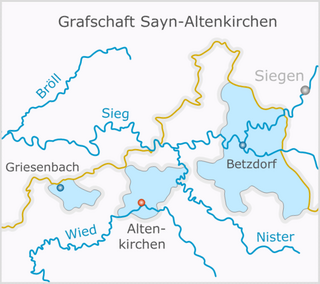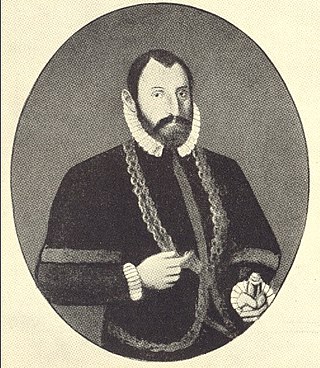
Sayn-Wittgenstein-Sayn-Altenkirchen was a German county located in what is now Rhineland-Palatinate, near the river Sieg.

Homburg Castle is an old hill castle in Nümbrecht, Oberbergischer Kreis in the German state of North Rhine-Westphalia.

Sayn-Wittgenstein was a county of medieval Germany, located in the Sauerland of eastern North Rhine-Westphalia.
Sayn-Homburg was a mediaeval county of Germany with its seat at Homburg Castle. It was created as a partition of Sponheim-Sayn in 1283. In 1345, Salentin, the son of Count Godfrey, married the heiress of Wittgenstein and the Counties were united and, on his death, merged to form the County of Sayn-Wittgenstein.

Sayn-Wittgenstein-Hachenburg was a German County located in Rhineland-Palatinate, near the river Sieg.

Sayn-Wittgenstein-Sayn was a county of Rhineland-Palatinate, Germany, comprising the lands of the region of Sayn. It was created as a partition of Sayn-Wittgenstein in 1607, although it was not until the next year that it obtained fully the Countship of Sayn. The succession was never clear, leading to the annexation of the county in 1623 by the Archbishop of Cologne. It was not until a treaty in 1648 that it was decided the county would pass to the sisters Ernestine and Johanette of Sayn-Wittgenstein-Sayn, under the regency of their mother, Countess Louise Juliane von Erbach (1603–1670). They partitioned the county into Sayn-Wittgenstein-Sayn-Altenkirchen and Sayn-Wittgenstein-Hachenburg soon after.
Henry III "the Great" was the count of Sayn (1202–1246), a county located near the Sieg River in northern Rhineland-Palatinate, Germany. Henry III shared the first year of his reign with his uncle, count Henry II, as he and his father Eberhard II had co-ruled the county. Gottfried II had been a regent from 1181 and continued until his death in 1220. John, count of Sponheim-Starkenburg, was regent from 1226 until Henry's death in 1246.
The House of Sponheim or Spanheim was a medieval German noble family, which originated in Rhenish Franconia. They were immediate Counts of Sponheim until 1437 and Dukes of Carinthia from 1122 until 1269. Its cadet branches ruled in the Imperial County of Ortenburg-Neuortenburg and various Sayn-Wittgenstein states until 1806.

The County of Sponheim was an independent territory in the Holy Roman Empire that lasted from the 11th century until the early 19th century. The name comes from the municipality of Sponheim, where the counts had their original residence.
Ernest Casimir of Nassau-Weilburg was the founder of the younger line of Nassau-Weilburg.
Countess Louise Juliane of Erbach was a German regent; Countess of Sayn-Wittgenstein-Sayn by marriage to Ernest of Sayn-Wittgenstein-Sayn, she acted temporarily as regent of Sayn-Wittgenstein-Sayn. She is remembered as the title character of the novel Die Gräfin von Sayn by Karl Ramseger-Mühle.

Louis I, Count of Sayn-Wittgenstein, nicknamed "the Elder", formally "Louis I of Sayn, Count at Wittgenstein" ruled the County of Wittgenstein, on the upper reaches of the rivers Lahn and Eder, from 1558 until his death. He converted his county to Calvinism and was an influential politician in the service to the Electoral Palatinate.
Johannetta, Countess of Sayn-Wittgenstein-Sayn-Altenkirchen, was Sovereign Countess of Sayn-Wittgenstein-Sayn-Altenkirchen from 1648 to 1701. She was also Landgravine of Hesse-Braubach by marriage to John, Landgrave of Hesse-Braubach, and Duchess of Saxe-Marksuhl by marriage to John George I, Duke of Saxe-Eisenach.
Ernestine of Sayn-Wittgenstein, was a German ruler, Sovereign Countess of Sayn-Wittgenstein-Hachenburg in 1648-1661. She was also Countess consort of Manderscheid-Blankenheim by marriage to.
Gottfried III, Count of Sponheim was a German nobleman. He succeeded his father Gottfried II as Count of Sponheim.

Henry IV of Sayn, Lord of Homburg, Montclair and Meinsberg was the last Count of Sayn-Sayn and the last male heir of the Sayn-Sponheim family.
Countess Mechthild of Sayn, also called Mechthild of Landsberg, Mechtild, Mechtildis or Mathilde, was the wife of Henry III of Sayn. She was an important figure in the Late Middle Ages because of her religious foundations (Stiftungen).











